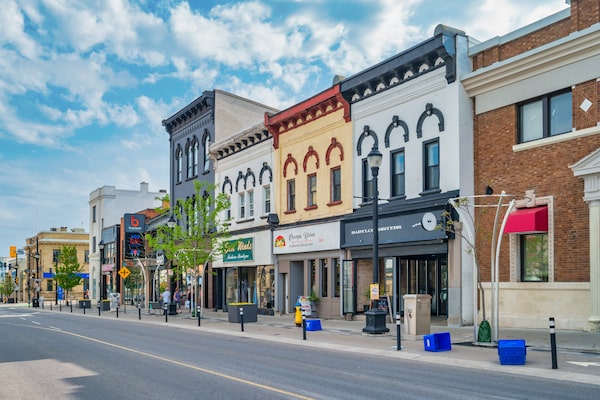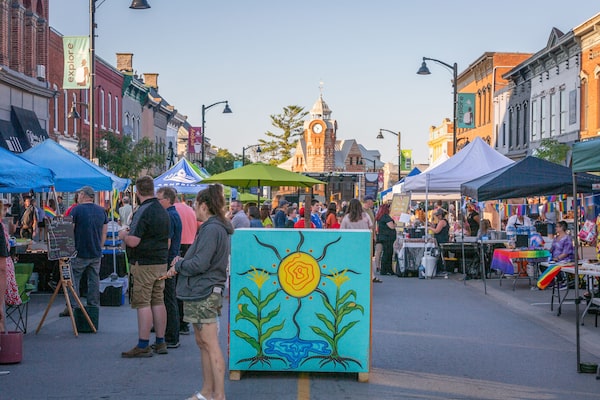
Upgrading historic buildings, developing parks and plazas and mobility, such as bicycling and ride sharing, can keep main streets vibrant and healthy.Getty Images
In the aftermath of the pandemic, small businesses along Canada’s main streets are still reporting below-normal revenues and business owner confidence is falling, studies by the Canadian Urban Institute are finding.
But greater public investment in infrastructure, incentives and changes in regulations can be effective in fostering growth and prosperity, experts said in a CityTalk webinar in March organized by the Canadian Urban Institute (CUI), a not-for-profit organization focused on urban issues.
“Main streets may not all look the same, but they are the connective tissue of every city in Canada. They deliver more than just commercial activity and services; they create social cohesion and access to collective experiences and culture,” says Mary W. Rowe, president and chief executive officer of CUI, which has been tracking trends in collaboration with business improvement organizations across Canada through a program called Bring Back Main Street.
“Main streets were challenged by the shift to digital purchasing that just accelerated during the pandemic. But at the same time, we’ve seen a renewed recognition that public investments in keeping main streets vibrant and healthy can create benefits for an entire city,” she adds.
There were more than 1,400 applications to the second round of My Main Street, a program to help revive businesses in Southern Ontario, says its managing director, Lindsay Webster. The $15-million program is funded by the Government of Canada through the Federal Economic Development Agency for Southern Ontario. It includes non-repayable loans for improvements of small businesses and grants to non-profit community organizations to create infrastructure and events that attract people to main streets.
Among the success stories from the program’s $23.25-million first round in 2021 are a patio program that tripled the return on investment for downtown Kitchener businesses and a shop in Brampton that used its $10,000 grant for a redesign which nearly doubled its space and increased sales.
Main streets may not all look the same, but they are the connective tissue of every city in Canada.
— Mary W. Rowe, president and chief executive officer, CUI
“It’s vital to address both the needs of commerce and people, and a challenge is the diversity of needs,” said Omer Ismail, economic development officer for the City of Toronto, whose Toronto Main Street Recovery and Rebuild Initiative is also funded through the Federal Economic Development Agency for Southern Ontario. It includes six programs to assist small businesses that range from matching funds for improvements and expansion of café spaces on city-owned property to grants for mitigating the impact of transit construction on commercial streets.
“Cities need to look at the main street as the golden goose and if you keep feeding it, it will continue to produce golden eggs,” says Janette MacDonald, CEO and founder of Shift Your Spend in London, Ont., which encourages consumers to spend their dollars in their own community. “Cities cannot stop investing in their main streets, which have the highest tax mill rates in the city. Keeping it prosperous makes the city prosperous. It’s something that councils need to keep in mind when they look at their budget priorities.”
New issues are arising that are making life more difficult for main street businesses, the panelists cautioned. A factor discouraging people from shopping main streets is the growing homeless population on urban streets, Ms. MacDonald notes. “It means that shopkeepers are keeping their doors locked. To have to ring a bell or bang on the door to get in really creates a barrier; you don’t really know if the stores are open and they might very well be closed because some stores aren’t keeping regular hours.”
Another growing challenge amid a push to accelerate building of new housing on commercial streets is that small businesses can be squeezed out, says Adam Lubinsky, a principal at New York-based design firm WXY Studio, which has opened an office in Toronto. New York created tax incentives for businesses that provide local services in commercial areas.

The main street of Arnprior, Ont. serves as a gathering place for community events and festivals.Amy O'Connor
“In Harlem, we limited the size of commercial units in buildings to avoid having banks and pharmacies that can afford the increased cost of rent taking over ground floor space that formerly housed a number of small independent businesses,” he says. “It’s not keeping out the businesses, it’s constraining the size of their floorplates to prevent big commercial units from dominating a block.”
Four factors need to all be addressed for the resiliency of main streets, says Dorian Moore, vice-president of Detroit-based Archive DS design studio, who has been involved in planning the redevelopment of Toronto’s Port Lands and was also a staff member of Detroit’s Land Use Master Plan Task Force.
“The first is the building, especially historic buildings that are assets and need to be upgraded or saved from the wrecking ball. The second is public space; the street is a primary public space, but attention also needs to be given to parks, playgrounds and plazas that attract people to the street, Mr. Moore says. “The third concern is mobility; in a shift to bicycling and ride sharing, we have to address their access. And finally, connectivity: The main street needs to be easy to access from the community around it.”
To keep main streets healthy, governments need to become more involved from the initial planning and offer tax incentives to help support the kind of small businesses and services that cater to the individuals who are living in the area, he recommends.